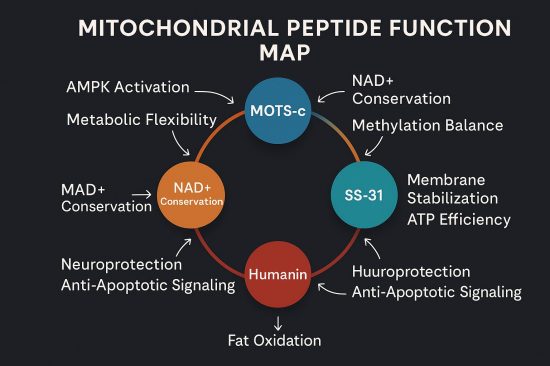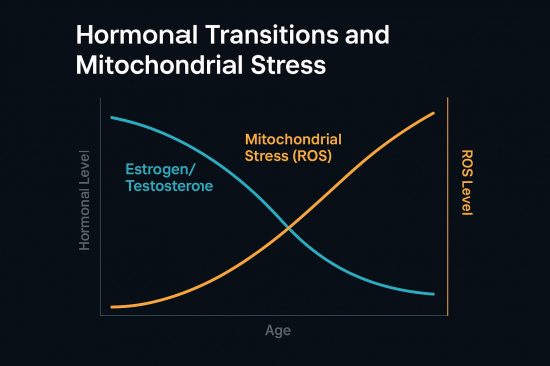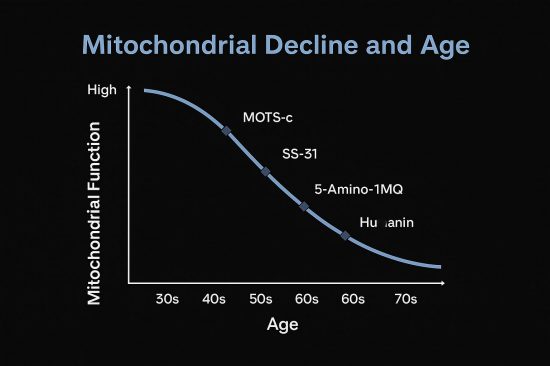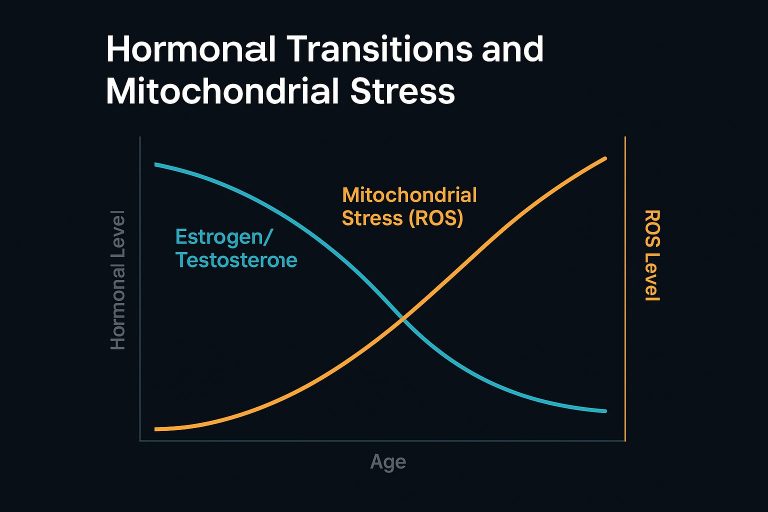Peptides for mitochondrial health are transforming how we think about fatigue, aging, and performance. If you’re training hard, eating well, and still feel like your body’s running at half power, the problem often lies deep within your cells — in how efficiently your mitochondria create energy.
Mitochondrial dysfunction occurs when these powerhouses can’t meet your body’s energy demands. It shows up as persistent fatigue, brain fog, hormonal imbalances, slower recovery, and stubborn fat gain — especially after 40. This isn’t just about age; it’s about cellular signaling breakdown. Chronic stress, inflammation, poor sleep, nutrient deficiencies, and toxin exposure all accelerate mitochondrial decline.
That’s where peptides for mitochondrial health come in. Research-backed compounds like MOTS-c, SS-31, 5-Amino-1MQ, SLU-PP-332, and Humanin work to reawaken dormant energy pathways, enhance metabolic flexibility, and protect against oxidative damage. These mitochondrial peptides for energy and longevity help restore efficient ATP production and promote healthy aging. Together, they help restore your body’s natural ability to produce clean energy, balance hormones, and recover faster from stress and training.
These peptides don’t replace healthy habits — they amplify them. By improving mitochondrial communication and resilience, they can help you move beyond surface-level fixes and address the root of fatigue and metabolic slowdown.
Disclaimer: This content is for research and educational purposes only. It is not medical advice and not intended to diagnose, treat, or prevent disease. Consult a licensed medical professional before using any peptide therapy.

When Energy Stalls, Start with Peptides for Mitochondrial Health
Before fatigue sets in or motivation fades, it’s often your mitochondria that begin to fall behind. These tiny powerhouses don’t just fuel your workouts — they drive hormone balance, brain clarity, and recovery. When mitochondrial function drops, energy stalls and even the best nutrition or training plan can plateau.
That’s where peptides for mitochondrial health come in. By reactivating the body’s cellular energy systems, these compounds help restore endurance, focus, and vitality from the inside out — turning sluggish metabolism into sustainable performance.

MOTS-c — The Metabolic Warrior
What it is: A mitochondrial-derived peptide (MDP) encoded within mitochondrial DNA.
How it works:
✅ Activates AMPK, the same metabolic switch triggered by fasting and exercise.
✅ Improves insulin sensitivity and glucose uptake in skeletal muscle.
✅ Promotes fat oxidation and supports healthy metabolic flexibility.
Why it matters: MOTS-c levels decline with age, reducing your body’s ability to efficiently switch between carbs and fats for energy. Studies link MOTS-c supplementation to improved glucose control, enhanced exercise performance, and reduced metabolic stress.
Best used for:
🔹 Insulin resistance or prediabetes
🔹 “Tired but wired” metabolism
🔹 Midlife body composition changes
SLU-PP-332 — The Exercise Mimetic
What it is: A potent ERR agonist (estrogen-related receptor) shown in animal studies to mimic many benefits of endurance training.
How it works:
✅ Increases oxidative metabolism and mitochondrial density.
✅ Enhances fatty acid oxidation—helping convert stored fat into fuel.
✅ Upregulates gene expression pathways involved in energy expenditure and stamina.
Why it matters: When joint pain, injury, or time limits your training, SLU-PP-332 can help “fill in the gaps” by signaling similar pathways as consistent aerobic work. It’s still preclinical, but early results show great promise.
Best used for:
🔹 Individuals with low exercise tolerance
🔹 Those recovering from injury or burnout
🔹 Anyone seeking a metabolic “boost” during low-activity phases
5-Amino-1MQ — The NAD⁺ Guardian
What it is: A selective NNMT inhibitor that prevents excessive methylation of nicotinamide, protecting NAD⁺ stores.
How it works:
✅ Increases energy expenditure and supports lipid metabolism.
✅ Enhances insulin sensitivity by improving cellular methylation balance.
✅ Supports NAD⁺-dependent repair and mitochondrial turnover.
Why it matters: NAD⁺ is essential for DNA repair and energy metabolism. Declining NAD⁺ is a hallmark of aging, contributing to slower recovery and brain fog. 5-Amino-1MQ helps restore that crucial energy economy.
Best used for:
🔹 Weight management and recomposition
🔹 Fatigue and poor recovery
🔹 NAD⁺ support without direct precursors
SS-31 (Elamipretide) — The Cardiolipin Guardian
What it is: A mitochondrial-targeted peptide that binds to cardiolipin, a phospholipid crucial for inner membrane structure and ATP production.
How it works:
✅ Stabilizes mitochondrial membranes under oxidative stress.
✅ Enhances ATP efficiency and reduces free radical damage.
✅ Improves endurance and recovery by maintaining cellular respiration.
Key research:
In 2025, the FDA granted accelerated approval to Elamipretide (Forzinity) for Barth Syndrome, a rare mitochondrial disease—marking the first-ever mitochondrial-specific drug approval.
Why it matters: SS-31 improves the “hardware” of energy production, particularly beneficial for fatigue, poor recovery, or chronic inflammation.
Best used for:
🔹 Chronic fatigue or mitochondrial dysfunction
🔹 High-intensity training recovery
🔹 Cardiovascular and muscular endurance
Humanin — The Neuroprotective Signal
What it is: Another mitochondrial-derived peptide (MDP) known for its anti-apoptotic and neuroprotective effects.
How it works:
✅ Protects cells against oxidative and inflammatory stress.
✅ Improves insulin sensitivity and glucose metabolism.
✅ Promotes cellular longevity via mitochondrial signaling pathways.
Why it matters: Humanin levels naturally decline with age, contributing to insulin resistance and brain fog. Its restoration may support mitochondrial communication between organs (muscle, brain, liver), improving overall resilience.
Best used for:
🔹 Cognitive support and mental clarity
🔹 Insulin resistance or neuroinflammation
🔹 Long-term mitochondrial protection
Hormonal Transitions and Mitochondrial Health

Women: Perimenopause → Menopause → Post-Menopause
During these transitions, estrogen—the body’s natural mitochondrial activator—declines sharply. This leads to reduced antioxidant protection, slower fat oxidation, and increased oxidative stress. Peptides for mitochondrial health can also play a role in supporting hormone balance during menopause and andropause, helping offset the metabolic slowdown linked to mitochondrial dysfunction.
✅ MOTS-c restores AMPK signaling, improving carb and fat metabolism.
✅ Humanin supports neuro-metabolic balance and antioxidant defense.
✅ SS-31 protects mitochondrial membranes and reduces oxidative fatigue.
✅ 5-Amino-1MQ maintains NAD⁺ balance for sustained energy.
✅ SLU-PP-332 keeps endurance pathways active when training consistency dips.
Suggested stack for women:
🔹 MOTS-c + Humanin base
🔹 Add SS-31 for fatigue and oxidative stress
🔹 Cycle 5-Amino-1MQ for recomposition phases
🔹 Include SLU-PP-332 during low-training periods or recovery blocks

Men: Andropause
Testosterone supports mitochondrial density and protein synthesis. As levels fall, oxidative stress rises and metabolic flexibility declines.
✅ MOTS-c enhances glucose uptake and stamina.
✅ 5-Amino-1MQ supports NAD⁺ and methylation balance.
✅ SS-31 protects the cardiovascular system and muscle mitochondria.
✅ Humanin helps preserve brain and vascular function.
✅ SLU-PP-332 boosts energy metabolism and endurance.
Suggested stack for men:
🔹 MOTS-c + 5-Amino-1MQ base
🔹 Add SS-31 for recovery and fatigue
🔹 Include Humanin for neuroprotection
🔹 Use SLU-PP-332 to amplify endurance
Stack Logic by Goal
By stacking these compounds strategically, users are effectively optimizing mitochondrial health with peptide therapy — supporting energy metabolism, resilience, and performance.
Prediabetes / Insulin Resistance
✅ MOTS-c + Humanin to improve glucose handling
🔹 Add 5-Amino-1MQ for NAD⁺ economy and insulin sensitivity
🔹 Use SS-31 for fatigue and oxidative balance
Visceral Fat / Fatty Liver
✅ MOTS-c + SLU-PP-332 to boost fat oxidation
🔹 Add 5-Amino-1MQ cycles for stubborn fat
🔹 Support with SS-31 for mitochondrial protection
Fatigue / Post-Illness Recovery
✅ SS-31 for mitochondrial membrane repair
🔹 MOTS-c to restore energy utilization
🔹 Humanin for cellular protection
Overreaching / High-Training Volume
✅ MOTS-c + SS-31 for metabolic and structural balance
🔹 Humanin background for anti-apoptotic protection
🔹 5-Amino-1MQ short cycles for body-comp improvement
Longevity / Cognitive Resilience
✅ MOTS-c + Humanin as foundational peptides
🔹 SS-31 periodically during illness or heavy stress
🔹 5-Amino-1MQ intermittently for metabolic drift

How to Implement This Practically
Peptides are most effective when paired with a mitochondria-supportive lifestyle.
✅ Strength Training: Prioritize compound lifts 3–5 days per week to increase mitochondrial density.
✅ Zone 2 Cardio: Low-intensity endurance (110–130 bpm) 2–3 times weekly improves fat oxidation.
✅ Sleep Optimization: Deep sleep drives mitochondrial repair and hormone balance.
✅ Nutrient Timing: Pair resistance training with amino acids, carnitine, and omega-3 fats.
✅ Sauna & Cold Therapy: Both enhance mitochondrial biogenesis and recovery.
✅ Supplements Synergy: Consider pairing with magnesium threonate, CoQ10, taurine, and D-ribose to support ATP generation.

Conditions Where Mitochondrial Peptides May Be Beneficial (For Further Research)
These are areas of active research only. Always consult a clinician before exploring peptide use.
🔹Metabolic & Endocrine: Insulin resistance, type 2 diabetes, obesity, hypothyroidism, adrenal fatigue
🔹 Neurological: Cognitive decline, Alzheimer’s, Parkinson’s, post-concussion recovery, chronic fatigue syndrome
🔹 Cardiovascular: Heart failure, endothelial dysfunction, poor circulation, hypertension
🔹 Musculoskeletal: Sarcopenia, muscle loss from aging, injury recovery, fibromyalgia
🔹 Autoimmune & Inflammatory: Rheumatoid arthritis, long-COVID fatigue, oxidative-stress-driven inflammation
🔹 Reproductive & Hormonal: Perimenopause, menopause, andropause, polycystic ovary syndrome
🔹General Longevity: Healthy aging, mitochondrial DNA protection, improved ATP turnover
These areas represent potential exploration points for future clinical and wellness applications. This peptide stack for metabolic health shows promise for those with chronic fatigue, insulin resistance, or age-related decline in cellular efficiency.
The Future of Mitochondrial Peptide Research
The next decade of peptide research will likely move beyond symptomatic treatment toward precision mitochondrial therapeutics—targeting metabolism, inflammation, and aging at their energetic roots.
✅ Human data expansion: MOTS-c and Humanin are entering small human trials for metabolic and neurodegenerative conditions.
✅ Combination therapy: Pairing mitochondrial peptides with NAD⁺ precursors, exercise, and hormetic stress may redefine “healthy aging.”
✅ Next-gen molecules: Derivatives of SS-31 and 5-Amino-1MQ are under investigation for chronic fatigue and cardiometabolic diseases.
✅ Bio-individual protocols: Personalized stacks based on lab markers (fasting glucose, VO₂ max, mitochondrial efficiency) will guide optimal dosing and cycling.
The ultimate goal isn’t to replace the body’s natural energy systems—but to restore and enhance them so you can age with vitality and resilience.
Ready to Rebuild Your Energy & Resilience?
Discover how anti-aging peptides, fitness, and functional lifestyle design can help you age actively—not passively. Your next chapter starts now.
Will you guide me through a personalized peptide protocol?
✅ Yes. I can help you understand which peptide categories may align with your goals — whether that’s improving energy, recovery, or longevity. While I don’t prescribe or sell peptides, I’ll guide you on how to structure your conversations with your practitioner and interpret research-backed strategies for safe, effective use.
Where do I get these peptides?
Peptides should only be sourced from reputable, licensed compounding pharmacies or research-based medical providers. I can point you toward legitimate channels or help you identify what questions to ask before purchasing to ensure quality and purity.
Can you help me request proper lab work?
✅ Absolutely. I’ll help you understand which labs to discuss with your practitioner — including metabolic panels, hormone markers, inflammation indicators, and mitochondrial function metrics — so your protocol is data-driven, not guesswork.
Can you help me communicate with my healthcare provider?
Yes. I can provide a professional outline or summary to bring to your practitioner, explaining what peptides or strategies you’re considering and the research supporting them. This helps you have an informed, collaborative discussion rather than a one-sided appointment.
Will you create a workout program that fits my peptide and health goals?
Yes. Whether your goal is strength, recomposition, fat loss, or endurance, I’ll design a training program that complements your peptide or recovery plan. Every program is customized to your schedule, equipment, and ability level.
Can you guide me with a nutrition plan that supports my protocol?
Definitely. I’ll help you build a nutrition plan that balances mitochondrial health, hormone optimization, and recovery — whether you’re following a low-carb, carnivore, or balanced whole-food approach. Nutrition and peptides should always work together for sustainable results.
Do I need to be local to work with you?
✅ No. I work with clients in person in San Diego and online worldwide. We can review your goals, build a strategy, and adjust your training and nutrition remotely with the same level of precision and accountability.